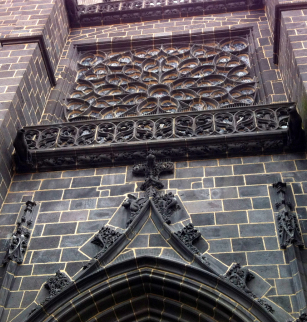Chapel of the Carmes-Déchaux convent

This chapel, with a style unique in the region, is from the 18th century. It is protected as a Historic Monument.Nearby, a cemetery, considered to be the “Père-Lachaise” of Clermont, is classified as a “significant cemetery” by the Association of Significant Cemeteries of Europe.
The chapel
On the site of a chapel and a cemetery, the cathedral canons founded the Chantoin monastery in the 12th century. In 1631, the fathers of the Secular Order of Discalced Carmelites settled into the building. But the convent and the church burned down in 1699.
The church was rebuilt between 1752 and 1775 by architect André Peyrat (circa 1695-1752). With a quatrefoil layout, the chapel has a dome ceiling. It is the only example of this type in the region. The main façade, made from Volvic stone, comprises two superimposed levels with a small cast-iron bell tower on top. The first concave level features the entrance door, framed by two pilasters with ionic capitals. The Louis XV-style door leaves are surmounted by a woodwork tympanum with the coat-of-arms of an archbishop and of the city of Clermont-Ferrand. The second level comprises a screen wall in the centre of which is a large bay lighting the sanctuary. This bay is flanked by two half-gables with inward-facing decorative scrolls reminiscent of “Roman” façades, along the lines of the Church of the Gesù in Rome.
The chapel was listed on the historic monuments registry in 1976. It was renovated in 2017 but closed to visitors.
The cemetery
The Carmes cemetery was inaugurated in 1816. Considered the “Père-Lachaise” of Clermont, it contains the sepulchres of great men from the City. These include politicians (Blatin, Charras), industrialists (Bargoin, Lecoq), artists (musicians Onslow and Claussmann, sculptors Chalonnax, Morel-Ladeuil and Mombur, architects Ledru and Jarrier), scientists (Alluard, Glangeaud) and intellectuals (Varenne, Mège). The Carmes cemetery is classified as a “significant cemetery” by the Association of Significant Cemeteries in Europe.
Near its entrance is a monument dedicated to Clermont inhabitants killed during the First World War (1914-1918). Created by the architect André Papillard (1880-1964) and the sculptor Jean Camus (1877-1955), its shape is reminiscent of an ancient Egyptian mastaba. This building is a contemporary of the monument in Place Salford, honouring veterans, with which it was part of a joint competition. It was inaugurated in 1924 and was listed as a historic monument in 2021.
Prices
- Free access.


















